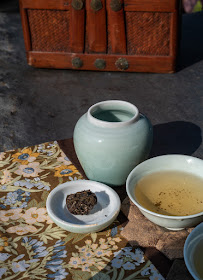This article continues to look at Washington's biography from a tea point of view. (See the
first article here). This time, I'm illustrating it with a special Chaxi on an old American flag. I call it, 'Crossing the Delaware', which is how General Washington turned the tide against the British army at the end of 1776. The wooden trays are symbols for the barges that were used to cross the river. I'm using 13 cups, one for each State in the Union at that time. Washington is symbolized with an old Dehua white teapot, his preferred color for his horse. The tea is Lapsang Souchong, the first red tea in history and one that has gone through smoke, for Washington was the first president and went through fire in battle! The dark bowl is a symbol for the black slavery in the US, the major stain in Washington's legacy. (He freed his own slaves in his will and hoped to set an example.)
- Page 257: "I told my messmates that I
could not carry our kettle any further. (...) Of what use was it? They had nothing to cook."
Hunger was another problem that plagued the American forces in their fight against the British.
- Page 331: "Tea and coffee replaced more potent beverages."
During periods of mourning the death of family members, alcohol wasn't consumed.
- Page 451: "Suddenly an avid consumer again, he went shopping for teapots, coffee urns, and other silverware for entertaining guests at Mount Vernon."
Having won the war, Washington turned to teapots! He's my hero!
- Page 466: "Washington showed up in the room of a sick guest, proffering a hot cup of tea."
The retired general remained a kind and decent host.
- Page 467: "Drank tea there in a very large circle of ladies. (...) met Powel alone for teas, and corresponded with her."
Washington was married, but liked the company of ladies. Did he have more than tea with them?
- Page 534: "While the convention dragged on, Washington drank enormous quantities of tea at the City Tavern and the Indian Queen"
In those days one would drink tea and socialize!
- Page 578: "He and Martha (the first lady) decided that she would entertain female visitors every Friday evening from seven to ten, serving tea, coffee, ice cream and lemonade."
This is how guests were entertained by the first president of the United States.
- Page 579: "Another observer noted that Washington seemed less austere at his wife's teas."
Tea made him feel more relaxed.
- Page 583: "Far from shunting off decorating on his wife or subordinates, he trusted his detailed knowledge of the decorative arts. To create a tea service, he melted down some old silver and had the finished products engraved with his griffin crest. (...) Washington oversaw the purchase of many objets d'art, including porcelain figures, silver spoons, and a china set embellished with the eagle of the Society of the Cincinnati."
An interest in art and elegance is what makes Washington complete. He knew that what you have shows to others who you are.
- Page 617: "Eager to augment presidential dignity, he bought more than tree hundred pieces of gilt-edged porcelain for dinner parties."
In those days, porcelain was also known as "white gold" and a sign of affluence.
- Page 645: "She kept up her Friday-evening receptions, which came to be ridiculed as the Republican Court, even though Martha, the most unaffected of first ladies, frequently prepared tea and coffee for visitors herself."
Even the modest wife of the hero of the USA was criticized by some! This is the lot of the powerful in a democracy. No matter what you do, you'll always have critics.
- Page 653: "In Georgetown, South Carolina, fifty ladies hosted him at a tea party."
Washington didn't like to attend official ceremonies in all the towns he visited, but he did enjoy such tea parties with many ladies! He would sometimes skip town early to avoid the ceremonial goodbyes. On the other hand, he would enter towns on his white horse, even though he traveled in a coach between towns, because he knew this is the image the people wanted to see.
- Page 684: "On December 13, 1792, Washington conversed with Jefferson about buying porcelain in Germany to dress the presidential table. He had inquired whether Samuel Shaw, the US consul at Canton, could acquire china there, but Shaw told him that it would take at least 2 years to arrive."
Thanks to modern progress, 2 weeks would be sufficient to order porcelain from China nowadays!
- Page 790: "While in Philadelphia, Washington delighted in joining Elizabeth Willing Powel for a number of teas and breakfasts that he conspicuously failed to enter into his diaries."
He was human after all...
- Page 807: "He (Dr. Craik) also had Washington inhale steam from a teapot filled with vinegar and hot water. When Washington tilted back his head to gargle sage tea mixed with vinegar, he nearly suffocated."
Neither sage tea nor teapot could save Washington who died on December 14, 1799 at age 67.
For this second Chaxi, I used a high mountain Oolong from a more recent tea mountain, Qilai. I chose it for its vigor and energy, characteristics that have become those of the United States.
My thanks Ron Chernow for this well documented biography. Looking at the past helps to understand the present. It's fascinating to see that human intrigues about power haven't changed that much since Washington!

























































